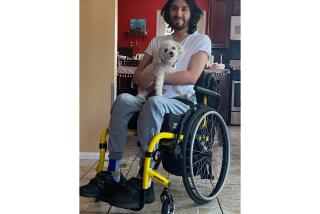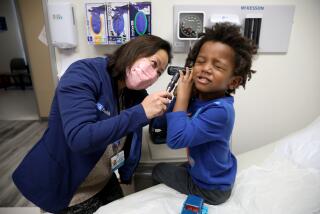L.A. surgeons implant device to help deaf 3-year-old hear
After a roughly six-hour operation, surgeons at Children’s Hospital Los Angeles have successfully inserted a device in the brain stem of a deaf 3-year-old boy in the hope that it will help him to hear.
The operation, the first in a clinical trial supported by the National Institutes of Health, could help set a precedent for the safety and efficacy of a surgery that has been performed for years abroad but is considered risky by some in the U.S. It is being led by researchers from the House Clinic in Los Angeles and USC.
“This is a great relief,” said Auguste Majkowski’s mother, Sophie Gareau, shortly after the surgery on Tuesday. Gareau, who traveled from Montreal for the procedure, wept after hearing from one of the doctors that her son’s operation went well.
Auguste, a lively toddler with a love of firetrucks and boundless energy, was born deaf. After he was diagnosed when he was a year and a half old, doctors surgically introduced a cochlear implant to help him hear. The implant uses an electrode array inserted into the inner ear, or cochlea, to directly stimulate the auditory nerve whenever the device picks up sound.
But Auguste’s cochlear implant didn’t work. The auditory nerve leading from the cochlea to the brain stem appeared to be missing — and without a natural “wire” to transmit sound to the brain stem, the device was of no use.
“I had to deal with that,” Gareau said. “It’s not easy to think something’s going to work, and then it’s not working.”
But the fact that Auguste had already had a cochlear implant actually made him a good candidate for the study, said House Clinic neurotologist Eric Wilkinson, one of the lead researchers for the clinical trial and one of the surgeons who performed Auguste’s operation. It showed that as far as hearing devices went, the ABI truly was the family’s only option.
“You don’t want to put a brainstem implant in if you don’t have to,” he said. “It’s more involved, there’s more risk, it’s a bigger surgery.”
The auditory brain stem implant, or ABI, offers a way to bypass that missing wire. Surgeons place a device on the cochlear nucleus, the part of the brain stem that receives sound, and use a network of electrodes to stimulate this spot directly.
Surgeons have used this device for years on people who have lost hearing because of an accident or a rare type of tumor that affects the auditory nerve, and who would not benefit from a cochlear implant. But it can’t help adults who have been deaf all their lives, because their brains have developed without exposure to sound.
In order to work in people who are born deaf, the device has to be implanted when they are very young.
To date, most ABI surgeries on young children have been done in Europe. A few operations have been performed on young children in the United States, but this would be the first NIH-funded, FDA-approved clinical trial to test it in kids who were born deaf, said USC audiologist Laurie Eisenberg.
Eisenberg is one of the lead investigators on the study, which seeks to implant the device in 10 young children. If the study shows it’s safe and effective, it could help clear the way for the implant surgery on young children to become a more accepted procedure in the U.S.
This surgery could be “a great alternative for families, just as long as they know the potential risks and potential benefits,” said Dr. Walter Kutz, a neurotologist at the University of Texas Southwestern Medical Center who was not involved in the research. “It could really change their lives for the better.”
The team of surgeons shook hands with Auguste’s parents Tuesday afternoon after completing the operation and successfully testing the ABI device to see whether the brain responded. Gareau and her husband, Christophe Majkowski, hugged tightly in a waiting room when they heard the news.
Auguste’s new ABI is scheduled to be turned on in mid-June.







